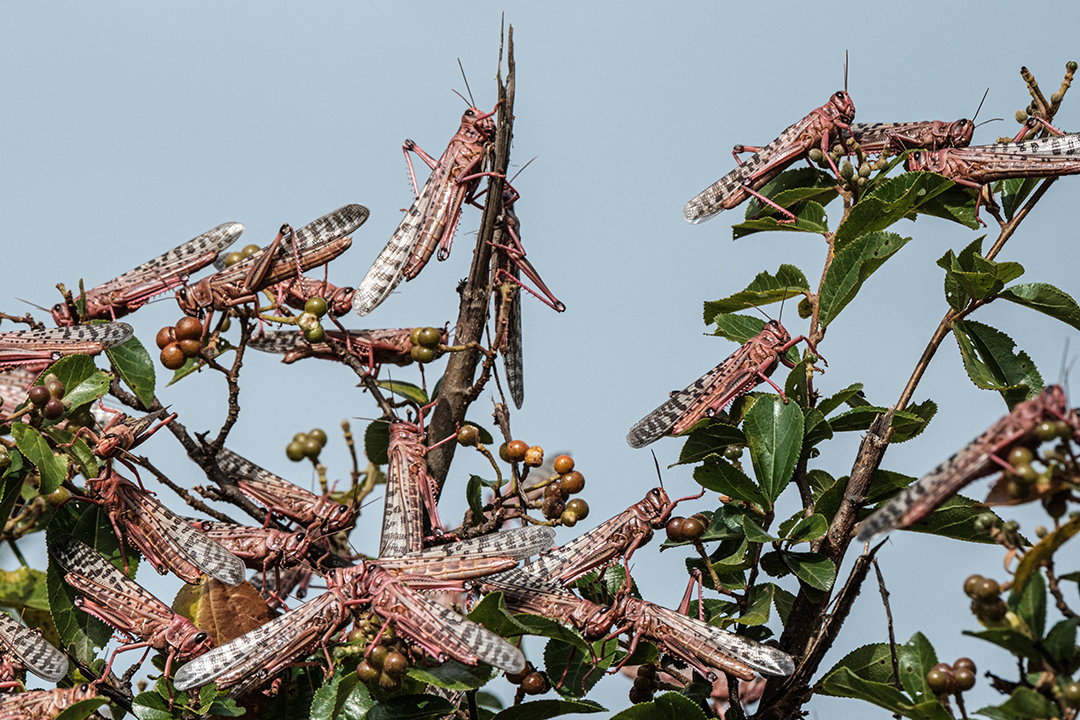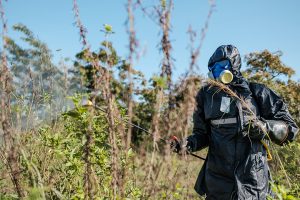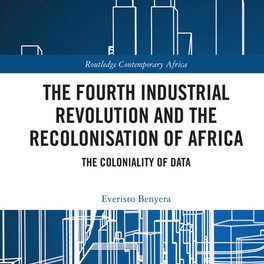The earth’s meteorological system has witnessed extreme variations in temperature and moisture patterns across millennia, but they were not driven by a species, until now. The Intergovernmental Panel on Climate Change (IPCC)’s latest Sixth Assessment Report (AR6), published in August 2021, confirmed that “it is unequivocal that human influence has warmed the atmosphere, ocean and land”.
With that, changes in the frequency and intensity of natural disasters have increased. Drought, floods, hurricanes, and epidemics all have serious implications for food and livelihood security, and in particular, communities that are ill-adapted to these extreme weather events. Natural disasters threaten development, but they are also good indicators of development failures.

Desert locusts covering a tree in Meru, Kenya, in February 2021. Photo: Yasuyoshi Chiba/AFP
In late 2019, Australia witnessed extreme bushfires, while heavy precipitation events spread across East Africa, India, and the Arabian Peninsula. These events were all unexpectedly linked to a climate phenomenon known as the Indian Ocean dipole.
This phenomenon is often referred to as the “neighbour” of the El Nino-Southern Oscillation, which is more widely known and describes the warming of the ocean surface in the central and eastern tropical Pacific Ocean. The dipole refers to the difference between sea surface temperatures across the western and eastern parts of the Indian Ocean. A positive Indian Ocean dipole event causes unusually warm sea surface temperatures in the equatorial western Indian Ocean and cooler temperatures in the east, thus less evaporation. Between October and December 2019, the Indian Ocean dipole experience was one of its strongest positive events ever.
Scientists have found that the western tropical of the Indian Ocean has been warming for more than a century at a faster rate than any other region of the tropical oceans. Climate models indicate that under SSP5–8.5 very high emissions scenario, there is likely to be a 22% increase in strong weather events associated with the Indian ocean dipole. The SSP5–8.5 refers to one of the five “Shared Socioeconomic Pathways” which input into the latest climate models to predict the ways in which the world might evolve in the absence of climate change policy.
This would increase the frequency of positive events from every 13 years to every eight years. A record-breaking number of cyclones developed over the Indian Ocean in 2019, creating ideal conditions for desert locust breeding and survival across the Arabian Peninsula. Climate change has played a crucial role in warming the Indian Ocean, and will have a strong effect on existing phenomenon like el Nino and the Indian Ocean dipole.
Desert locusts (Schistocerca gregaria) occur in swarms due to a particular combination of weather, soil and vegetation conditions that complement their reproduction and mutation from an otherwise solitary creature into one that matures and develops into speedy swarms (gregarisation) of up to 150 million locusts.
Desert locusts are one the most destructive pests due to this mutation. Their ability to rapidly develop into swarms, migrate across regions and states, quickly destroying cropland, makes them especially devastating. A swarm the size of Paris can eat the same amount of food in one day as half the population of France. In 2020, East Africa experienced its worst desert locust outbreak in several decades. The Food and Agriculture Organisation (FAO) estimates that across the Horn of Africa, at least 40 million people were faced with acute food insecurity in the 10 affected countries.

A Uganda People’s Defence Forces (UPDF) soldier sprays plants with insecticides, with the hope of killing desert locusts, in Otuke, Uganda in February 2020. Photo: Sumy Sadurni/AFP
Despite an early warning by the Desert Locust Watch agency during the 2019 cyclone season, the invasion could not be stopped in time. Knowledge on the ecology of desert locusts has developed considerably over time, but without international policy and implementation cooperation, the species is insufficiently understood. National governments must formalise the procedures and strategies agreed upon at the regional level.
In 1962, the Desert Locust Control Organisation for Eastern Africa (DLCO-EA) was established to unify cooperation between the governments of Ethiopia, Somalia, Tanzania, Kenya and Uganda. The DLCO-EA hoped to ensure cooperation in the control of desert locust plagues across the region. Despite having the necessary scientific understanding of how to deal with the locusts, the organisation has struggled to deal with the magnitude of the current outbreak.
The desert locust disaster is an example of the disconnect between the actions of regional organisations and the preparedness of national locust control units. Although quantitative risk modelling is an important aspect of preparedness, grasping the context-specific scenario within affected states will ultimately determine the success or failure of a disaster risk management plan.
Every eight weeks a new generation of locusts can emerge and with each new generation, on average, there is a 20-fold increase in its population size. This makes it critical to act once a resurgence is detected. In 2020, East Africa and Yemen recorded $8.5-billion worth of livelihood damages due to the outbreak. Many of the affected households already struggle to meet basic needs.
Currently, the regional food security situation in the Horn of Africa is a major concern. One in five people need immediate humanitarian food assistance in the region. Sudan, Ethiopia and South Sudan have the largest groups of food insecure citizens in Africa as well as the highest burden of malnutrition. The core drivers of this food insecurity include conflict, climate shocks, macroeconomic instability, and the COVID-19 pandemic.
Predictions indicate that drier-than-normal conditions and higher land surface temperatures, combined with previous season rainfall deficits, will have a severe impact on crops and water resource replenishment across the region.
In September 2021, the threat of another desert locust upsurge became apparent and due to the limited accessibility of Ethiopia’s northern region due to the Tigray conflict, accurate swarm migration predictions could not be made. At the time of writing, in November last year, conditions don’t favour continued breeding. However, the availability of green vegetation, wind direction and speed, and forecasted weather conditions, put several areas at high risk of swarm invasion and adult locust development.
Funding shortfalls have been one of the major factors hindering control operations facing regional organisations like the DLCO-EA, as well as member states. Cooperation between DLCO-EA member states and regional environmental centres was initially weak, but has improved significantly since 2019. Collaboration at regional and national levels has been facilitated through regular ministerial conferences, to fine-tune the findings of assessments and to develop actionable recommendations to improve preparedness to respond to current and future desert locust outbreaks.
Last year’s COP26 was a breakthrough for risk and resilience financing. The United Nations Disaster Risk Reduction (UNDRR) agency made a plea for more ambitious efforts to reduce and manage climate change-induced risks, focusing on an equal financial pledge between adaptation and mitigation. An amount of $350 million has subsequently been committed to the Adaptation Fund, the highest amount mobilised since the fund’s inception. First-time contributions from the United States, Canada and Qatar were pledged alongside increased contributions by the European Union, Spain, Quebec, Ireland and Belgium, among several others.
The UNDRR also called for increased support for the Santiago Network, which helps provide technical assistance, knowledge and resources to countries affected by climate change risks. Compared to previous COP sessions, Glasgow saw a stronger dialogue on loss and damage as a consequence of climate change.
Governments acknowledge that risk-informed strategies and actions must be anchored in the available disaster risk data. As East Africa’s locust crisis has demonstrated, scaling up disaster preparedness is a vital element that African countries must include in their national climate change policy.
Would you like to gain an understanding of your own impact on the environment? Calculate your own carbon footprint here










